Abstract
Velo-cardio-facial syndrome (VCFS) is a relatively common developmental disorder characterized by craniofacial anomalies and conotruncal heart defects. Many VCFS patients have hemizygous deletions for a part of 22q11, suggesting that haploinsufficiency in this region is responsible for its etiology. Because most cases of VCFS are sporadic, portions of 22q11 may be prone to rearrangement. To understand the molecular basis for chromosomal deletions, we defined the extent of the deletion, by genotyping 151 VCFS patients and performing haplotype analysis on 105, using 15 consecutive polymorphic markers in 22q11. We found that 83% had a deletion and >90% of these had a similar approximately 3 Mb deletion, suggesting that sequences flanking the common breakpoints are susceptible to rearrangement. We found no correlation between the presence or size of the deletion and the phenotype. To further define the chromosomal breakpoints among the VCFS patients, we developed somatic hybrid cell lines from a set of VCFS patients. An 11-kb resolution physical map of a 1,080-kb region that includes deletion breakpoints was constructed, incorporating genes and expressed sequence tags (ESTs) isolated by the hybridization selection method. The ordered markers were used to examine the two separated copies of chromosome 22 in the somatic hybrid cell lines. In some cases, we were able to map the chromosome breakpoints within a single cosmid. A 480-kb critical region for VCFS has been delineated, including the genes for GSCL, CTP, CLTD, HIRA, and TMVCF, as well as a number of novel ordered ESTs.
Full text
PDF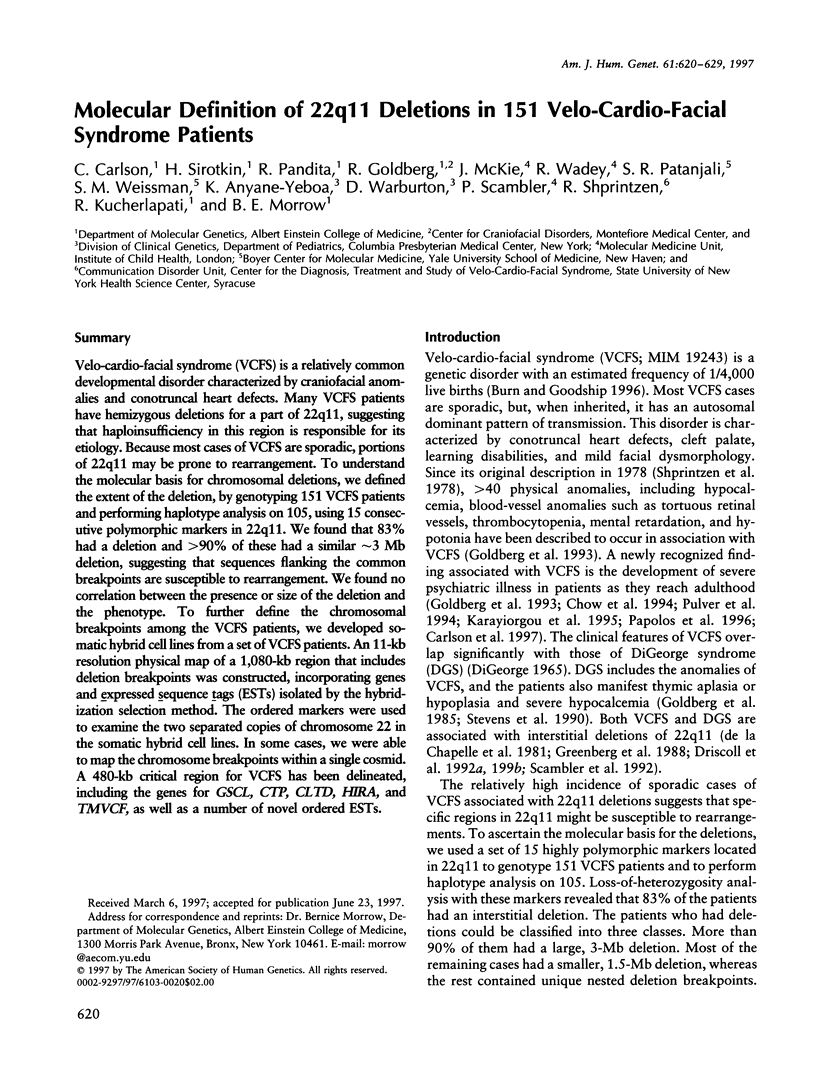
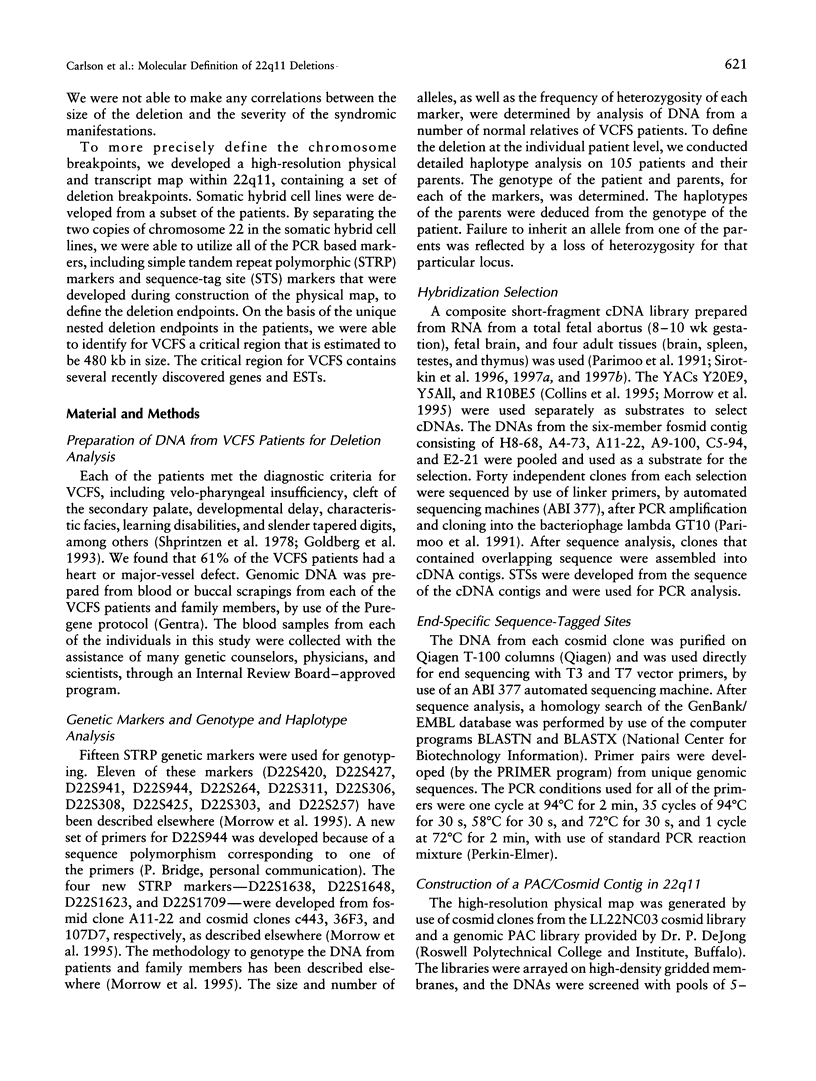
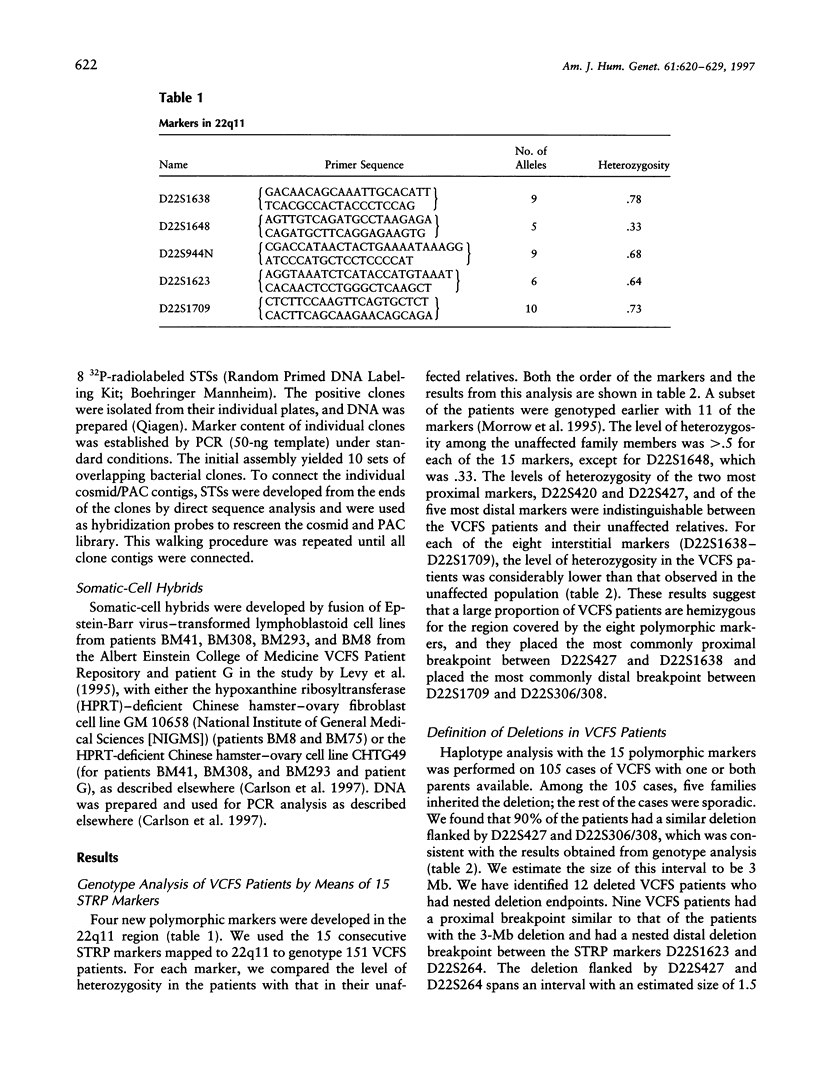
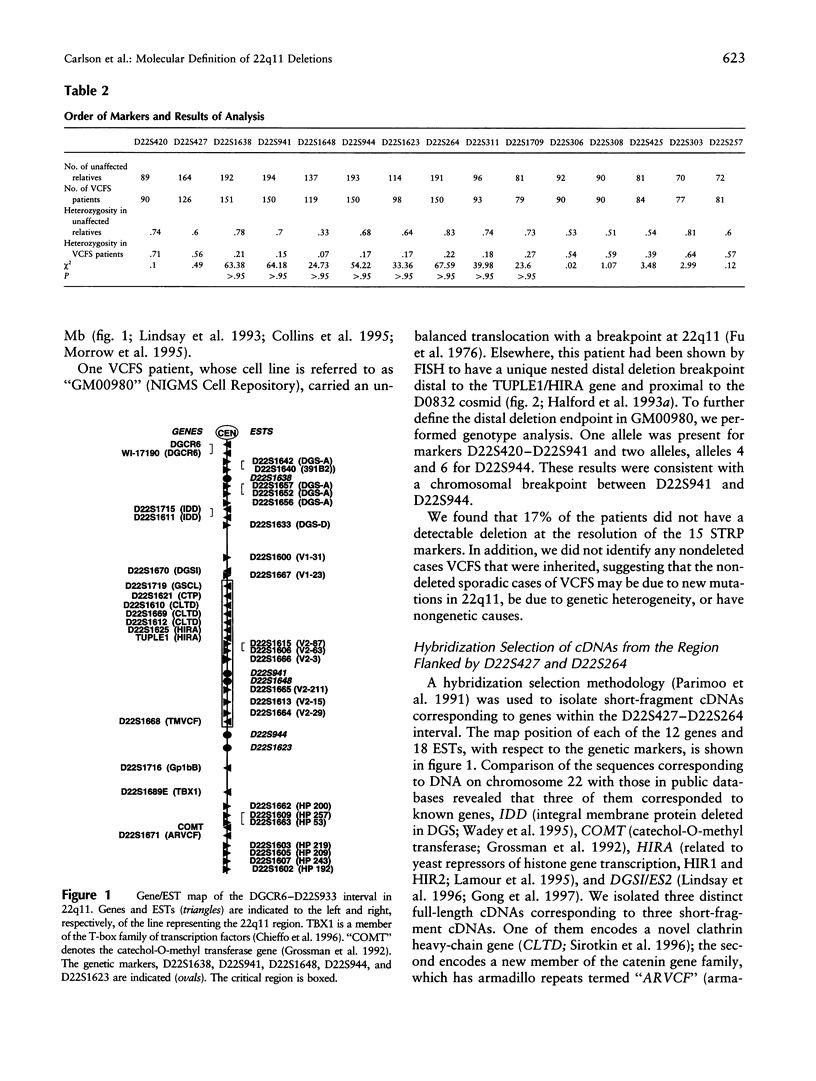
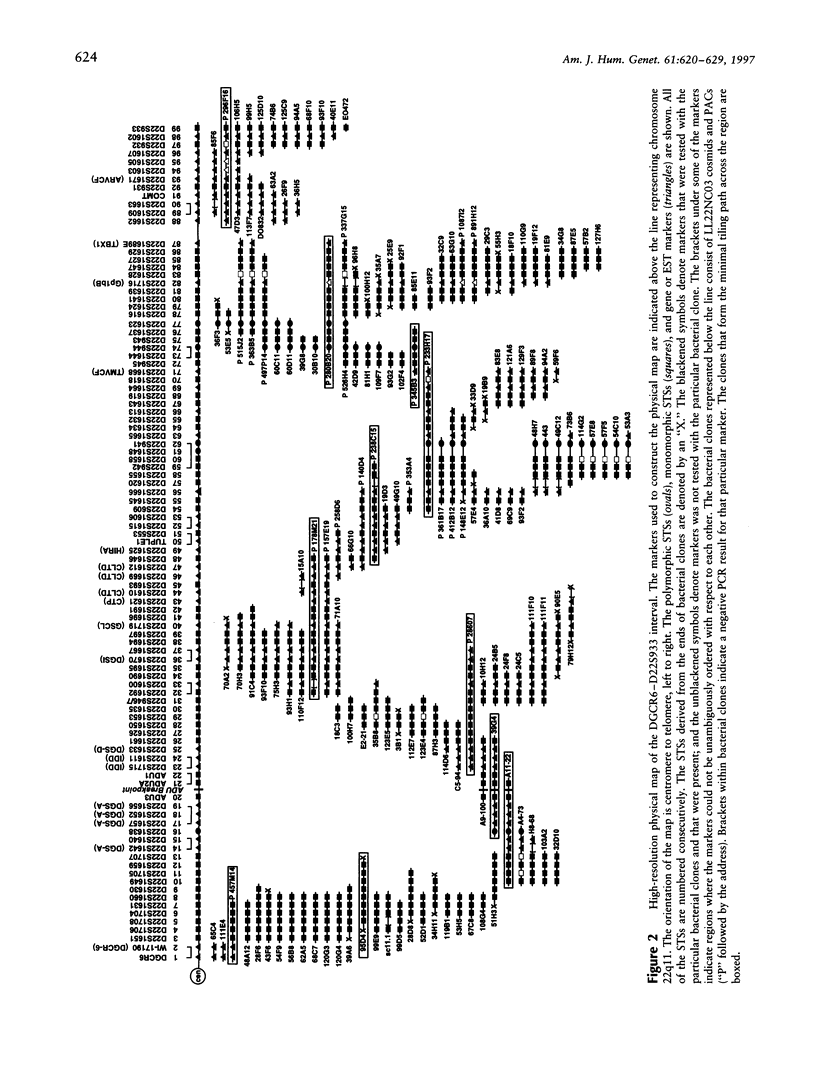
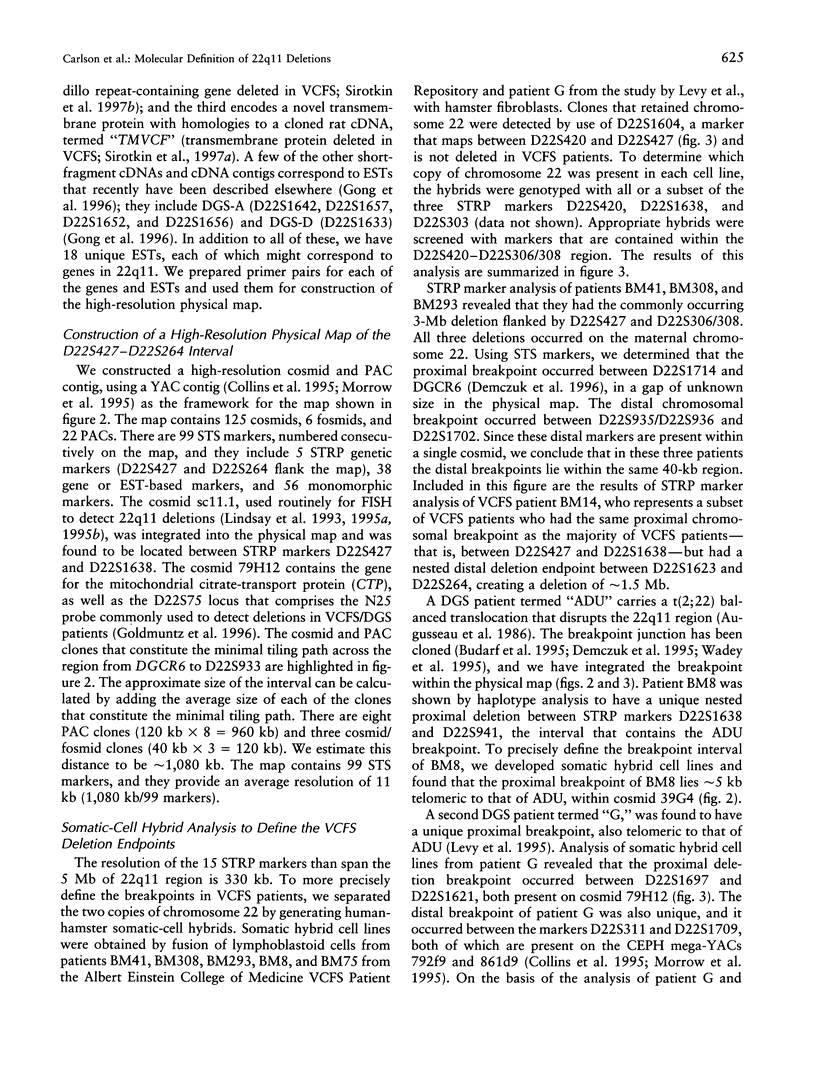
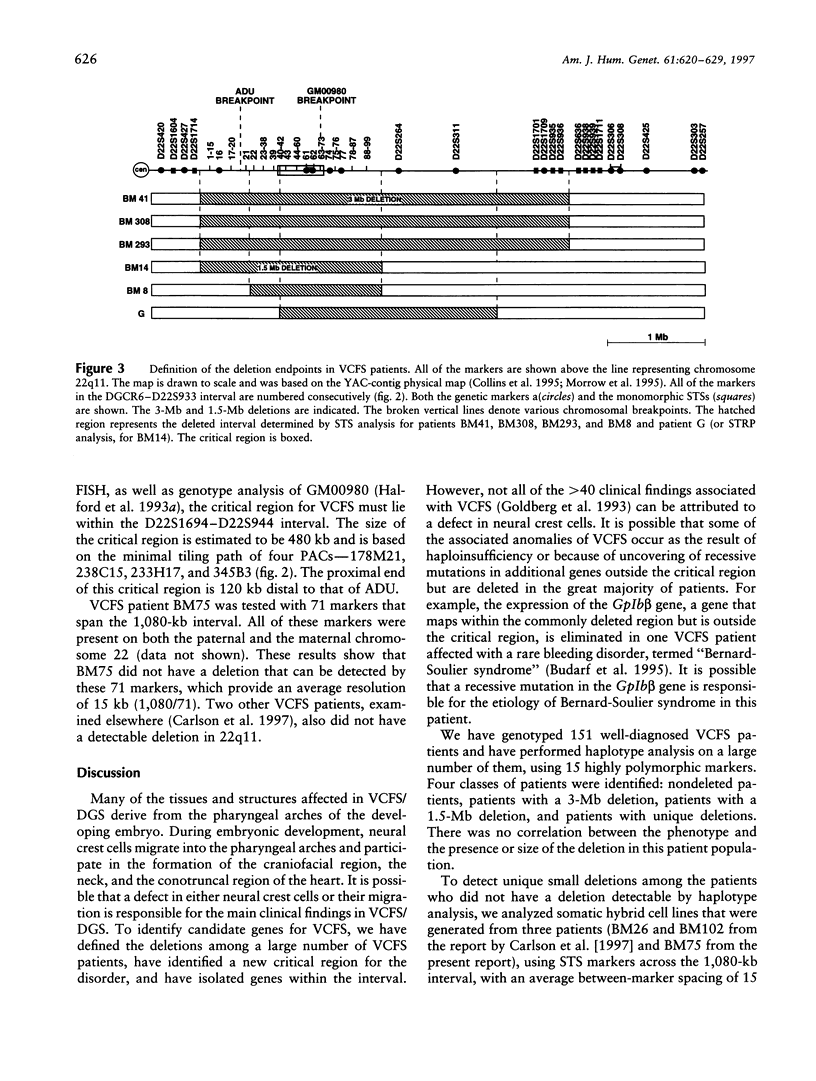
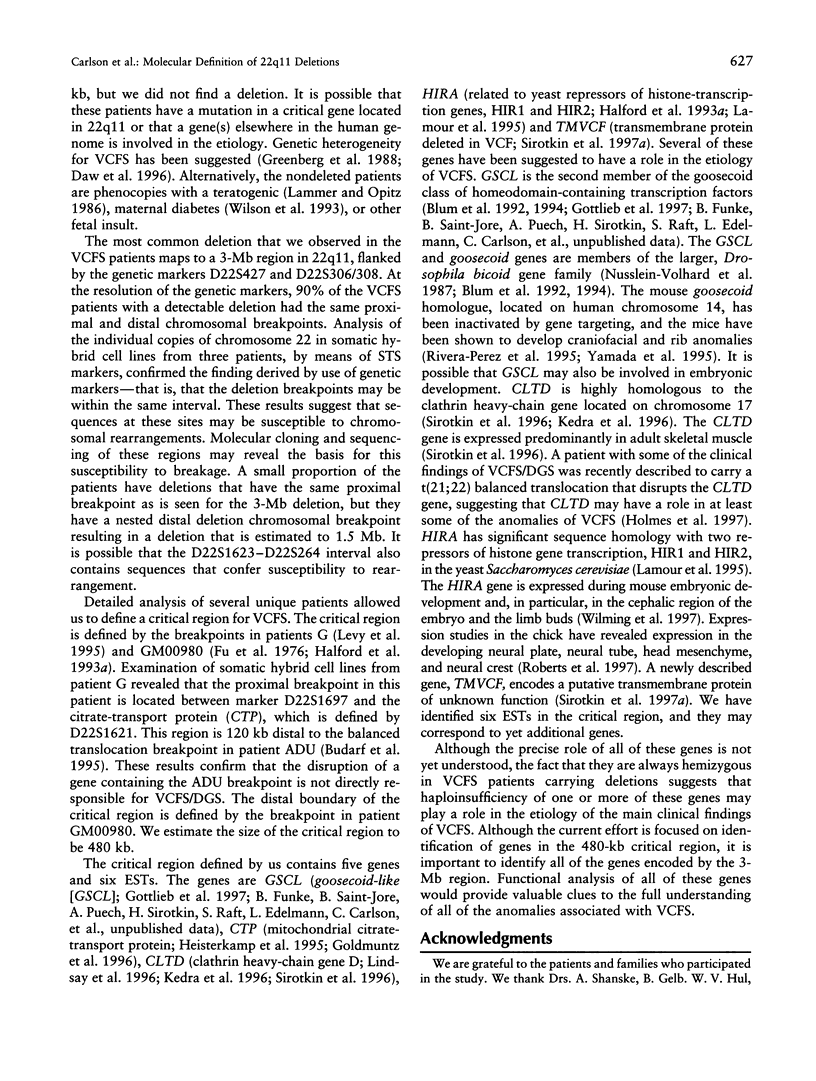
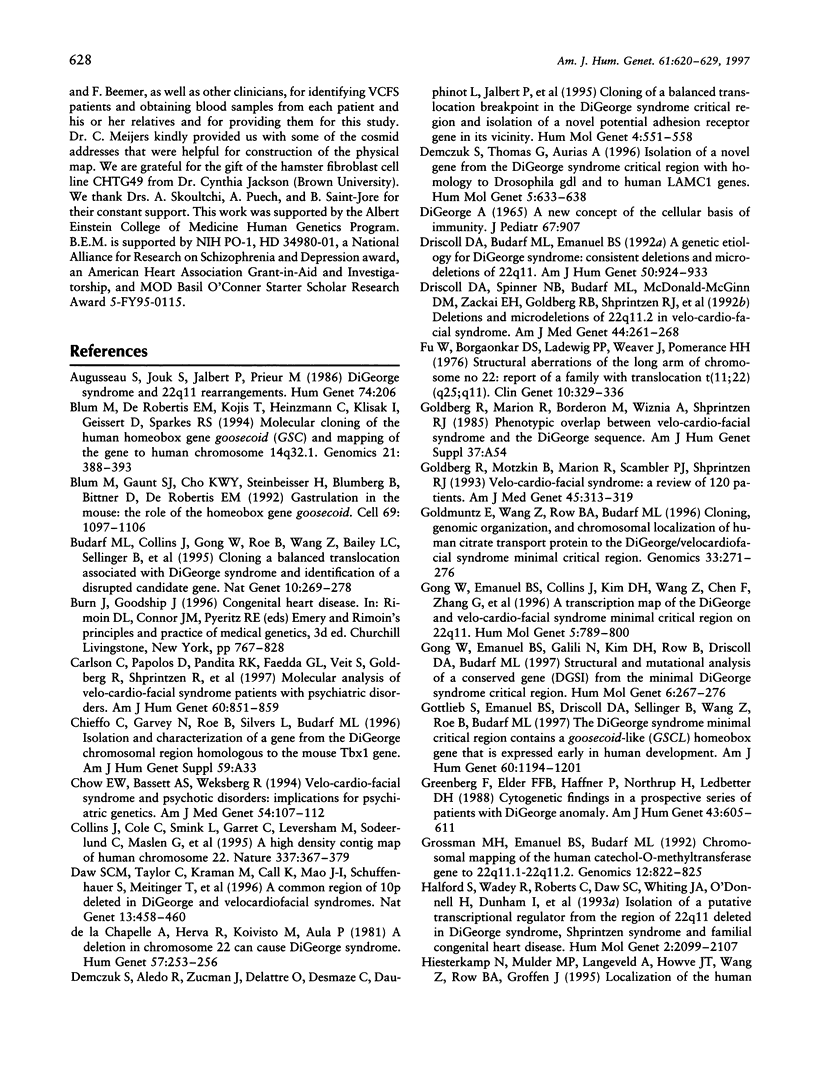
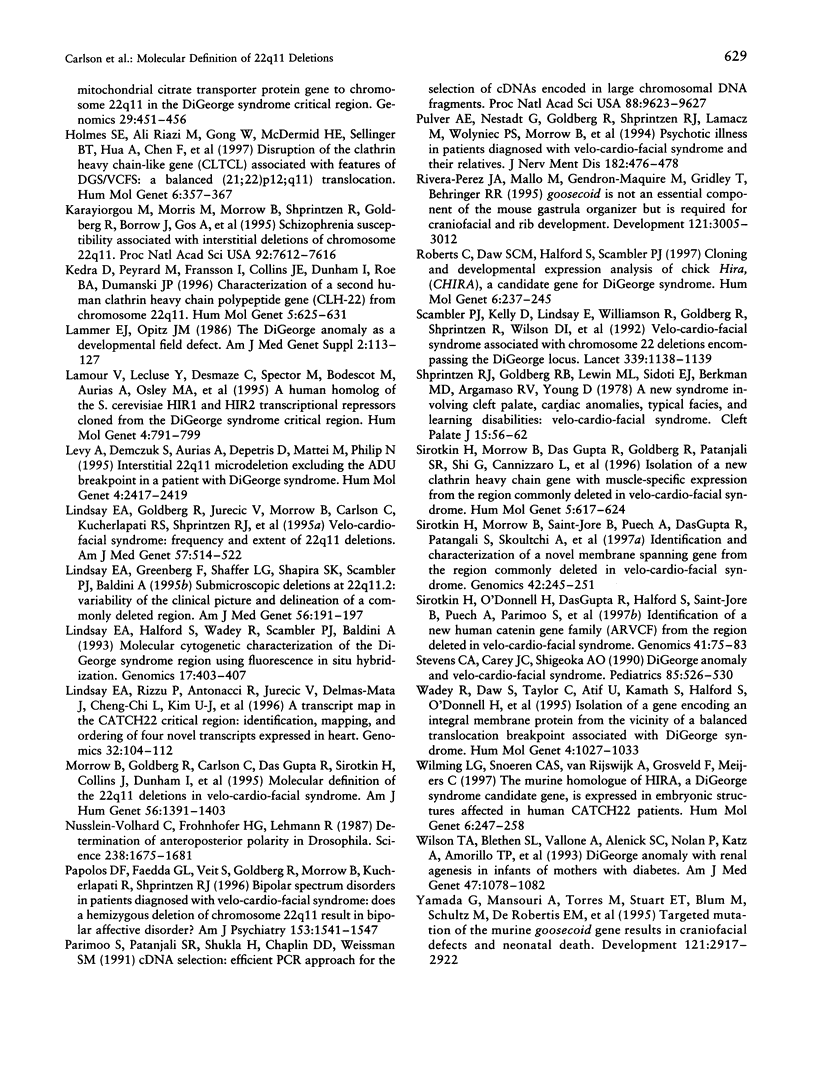
Selected References
These references are in PubMed. This may not be the complete list of references from this article.
- Augusseau S., Jouk S., Jalbert P., Prieur M. DiGeorge syndrome and 22q11 rearrangements. Hum Genet. 1986 Oct;74(2):206–206. doi: 10.1007/BF00282098. [DOI] [PubMed] [Google Scholar]
- Blum M., De Robertis E. M., Kojis T., Heinzmann C., Klisak I., Geissert D., Sparkes R. S. Molecular cloning of the human homeobox gene goosecoid (GSC) and mapping of the gene to human chromosome 14q32.1. Genomics. 1994 May 15;21(2):388–393. doi: 10.1006/geno.1994.1281. [DOI] [PubMed] [Google Scholar]
- Blum M., Gaunt S. J., Cho K. W., Steinbeisser H., Blumberg B., Bittner D., De Robertis E. M. Gastrulation in the mouse: the role of the homeobox gene goosecoid. Cell. 1992 Jun 26;69(7):1097–1106. doi: 10.1016/0092-8674(92)90632-m. [DOI] [PubMed] [Google Scholar]
- Budarf M. L., Collins J., Gong W., Roe B., Wang Z., Bailey L. C., Sellinger B., Michaud D., Driscoll D. A., Emanuel B. S. Cloning a balanced translocation associated with DiGeorge syndrome and identification of a disrupted candidate gene. Nat Genet. 1995 Jul;10(3):269–278. doi: 10.1038/ng0795-269. [DOI] [PubMed] [Google Scholar]
- Carlson C., Papolos D., Pandita R. K., Faedda G. L., Veit S., Goldberg R., Shprintzen R., Kucherlapati R., Morrow B. Molecular analysis of velo-cardio-facial syndrome patients with psychiatric disorders. Am J Hum Genet. 1997 Apr;60(4):851–859. [PMC free article] [PubMed] [Google Scholar]
- Chow E. W., Bassett A. S., Weksberg R. Velo-cardio-facial syndrome and psychotic disorders: implications for psychiatric genetics. Am J Med Genet. 1994 Jun 15;54(2):107–112. doi: 10.1002/ajmg.1320540205. [DOI] [PMC free article] [PubMed] [Google Scholar]
- Collins J. E., Cole C. G., Smink L. J., Garrett C. L., Leversha M. A., Soderlund C. A., Maslen G. L., Everett L. A., Rice K. M., Coffey A. J. A high-density YAC contig map of human chromosome 22. Nature. 1995 Sep 28;377(6547 Suppl):367–379. doi: 10.1038/377367a0. [DOI] [PubMed] [Google Scholar]
- Daw S. C., Taylor C., Kraman M., Call K., Mao J., Schuffenhauer S., Meitinger T., Lipson T., Goodship J., Scambler P. A common region of 10p deleted in DiGeorge and velocardiofacial syndromes. Nat Genet. 1996 Aug;13(4):458–460. doi: 10.1038/ng0896-458. [DOI] [PubMed] [Google Scholar]
- Demczuk S., Aledo R., Zucman J., Delattre O., Desmaze C., Dauphinot L., Jalbert P., Rouleau G. A., Thomas G., Aurias A. Cloning of a balanced translocation breakpoint in the DiGeorge syndrome critical region and isolation of a novel potential adhesion receptor gene in its vicinity. Hum Mol Genet. 1995 Apr;4(4):551–558. doi: 10.1093/hmg/4.4.551. [DOI] [PubMed] [Google Scholar]
- Demczuk S., Thomas G., Aurias A. Isolation of a novel gene from the DiGeorge syndrome critical region with homology to Drosophila gdl and to human LAMC1 genes. Hum Mol Genet. 1996 May;5(5):633–638. doi: 10.1093/hmg/5.5.633. [DOI] [PubMed] [Google Scholar]
- Driscoll D. A., Budarf M. L., Emanuel B. S. A genetic etiology for DiGeorge syndrome: consistent deletions and microdeletions of 22q11. Am J Hum Genet. 1992 May;50(5):924–933. [PMC free article] [PubMed] [Google Scholar]
- Driscoll D. A., Spinner N. B., Budarf M. L., McDonald-McGinn D. M., Zackai E. H., Goldberg R. B., Shprintzen R. J., Saal H. M., Zonana J., Jones M. C. Deletions and microdeletions of 22q11.2 in velo-cardio-facial syndrome. Am J Med Genet. 1992 Sep 15;44(2):261–268. doi: 10.1002/ajmg.1320440237. [DOI] [PubMed] [Google Scholar]
- Fu W., Borgaonkar D. S., Ladewig P. P., Weaver J., Pomerance H. H. Structural aberrations of the long arm of chromosome no. 22. Report fo a family with translocation t(11;22) (q25;q11). Clin Genet. 1976 Dec;10(6):329–336. doi: 10.1111/j.1399-0004.1976.tb00057.x. [DOI] [PubMed] [Google Scholar]
- Goldberg R., Motzkin B., Marion R., Scambler P. J., Shprintzen R. J. Velo-cardio-facial syndrome: a review of 120 patients. Am J Med Genet. 1993 Feb 1;45(3):313–319. doi: 10.1002/ajmg.1320450307. [DOI] [PubMed] [Google Scholar]
- Goldmuntz E., Wang Z., Roe B. A., Budarf M. L. Cloning, genomic organization, and chromosomal localization of human citrate transport protein to the DiGeorge/velocardiofacial syndrome minimal critical region. Genomics. 1996 Apr 15;33(2):271–276. doi: 10.1006/geno.1996.0191. [DOI] [PubMed] [Google Scholar]
- Gong W., Emanuel B. S., Collins J., Kim D. H., Wang Z., Chen F., Zhang G., Roe B., Budarf M. L. A transcription map of the DiGeorge and velo-cardio-facial syndrome minimal critical region on 22q11. Hum Mol Genet. 1996 Jun;5(6):789–800. doi: 10.1093/hmg/5.6.789. [DOI] [PubMed] [Google Scholar]
- Gong W., Emanuel B. S., Galili N., Kim D. H., Roe B., Driscoll D. A., Budarf M. L. Structural and mutational analysis of a conserved gene (DGSI) from the minimal DiGeorge syndrome critical region. Hum Mol Genet. 1997 Feb;6(2):267–276. doi: 10.1093/hmg/6.2.267. [DOI] [PubMed] [Google Scholar]
- Gottlieb S., Emanuel B. S., Driscoll D. A., Sellinger B., Wang Z., Roe B., Budarf M. L. The DiGeorge syndrome minimal critical region contains a goosecoid-like (GSCL) homeobox gene that is expressed early in human development. Am J Hum Genet. 1997 May;60(5):1194–1201. [PMC free article] [PubMed] [Google Scholar]
- Greenberg F., Elder F. F., Haffner P., Northrup H., Ledbetter D. H. Cytogenetic findings in a prospective series of patients with DiGeorge anomaly. Am J Hum Genet. 1988 Nov;43(5):605–611. [PMC free article] [PubMed] [Google Scholar]
- Grossman M. H., Emanuel B. S., Budarf M. L. Chromosomal mapping of the human catechol-O-methyltransferase gene to 22q11.1----q11.2. Genomics. 1992 Apr;12(4):822–825. doi: 10.1016/0888-7543(92)90316-k. [DOI] [PubMed] [Google Scholar]
- Halford S., Wadey R., Roberts C., Daw S. C., Whiting J. A., O'Donnell H., Dunham I., Bentley D., Lindsay E., Baldini A. Isolation of a putative transcriptional regulator from the region of 22q11 deleted in DiGeorge syndrome, Shprintzen syndrome and familial congenital heart disease. Hum Mol Genet. 1993 Dec;2(12):2099–2107. doi: 10.1093/hmg/2.12.2099. [DOI] [PubMed] [Google Scholar]
- Heisterkamp N., Mulder M. P., Langeveld A., ten Hoeve J., Wang Z., Roe B. A., Groffen J. Localization of the human mitochondrial citrate transporter protein gene to chromosome 22Q11 in the DiGeorge syndrome critical region. Genomics. 1995 Sep 20;29(2):451–456. doi: 10.1006/geno.1995.9982. [DOI] [PubMed] [Google Scholar]
- Holmes S. E., Riazi M. A., Gong W., McDermid H. E., Sellinger B. T., Hua A., Chen F., Wang Z., Zhang G., Roe B. Disruption of the clathrin heavy chain-like gene (CLTCL) associated with features of DGS/VCFS: a balanced (21;22)(p12;q11) translocation. Hum Mol Genet. 1997 Mar;6(3):357–367. doi: 10.1093/hmg/6.3.357. [DOI] [PubMed] [Google Scholar]
- Karayiorgou M., Morris M. A., Morrow B., Shprintzen R. J., Goldberg R., Borrow J., Gos A., Nestadt G., Wolyniec P. S., Lasseter V. K. Schizophrenia susceptibility associated with interstitial deletions of chromosome 22q11. Proc Natl Acad Sci U S A. 1995 Aug 15;92(17):7612–7616. doi: 10.1073/pnas.92.17.7612. [DOI] [PMC free article] [PubMed] [Google Scholar]
- Kedra D., Peyrard M., Fransson I., Collins J. E., Dunham I., Roe B. A., Dumanski J. P. Characterization of a second human clathrin heavy chain polypeptide gene (CLH-22) from chromosome 22q11. Hum Mol Genet. 1996 May;5(5):625–631. doi: 10.1093/hmg/5.5.625. [DOI] [PubMed] [Google Scholar]
- Lammer E. J., Opitz J. M. The DiGeorge anomaly as a developmental field defect. Am J Med Genet Suppl. 1986;2:113–127. doi: 10.1002/ajmg.1320250615. [DOI] [PubMed] [Google Scholar]
- Lamour V., Lécluse Y., Desmaze C., Spector M., Bodescot M., Aurias A., Osley M. A., Lipinski M. A human homolog of the S. cerevisiae HIR1 and HIR2 transcriptional repressors cloned from the DiGeorge syndrome critical region. Hum Mol Genet. 1995 May;4(5):791–799. doi: 10.1093/hmg/4.5.791. [DOI] [PubMed] [Google Scholar]
- Levy A., Demczuk S., Aurias A., Depétris D., Mattei M. G., Philip N. Interstitial 22q11 microdeletion excluding the ADU breakpoint in a patient with DiGeorge syndrome. Hum Mol Genet. 1995 Dec;4(12):2417–2419. doi: 10.1093/hmg/4.12.2417. [DOI] [PubMed] [Google Scholar]
- Lindsay E. A., Goldberg R., Jurecic V., Morrow B., Carlson C., Kucherlapati R. S., Shprintzen R. J., Baldini A. Velo-cardio-facial syndrome: frequency and extent of 22q11 deletions. Am J Med Genet. 1995 Jul 3;57(3):514–522. doi: 10.1002/ajmg.1320570339. [DOI] [PubMed] [Google Scholar]
- Lindsay E. A., Greenberg F., Shaffer L. G., Shapira S. K., Scambler P. J., Baldini A. Submicroscopic deletions at 22q11.2: variability of the clinical picture and delineation of a commonly deleted region. Am J Med Genet. 1995 Mar 27;56(2):191–197. doi: 10.1002/ajmg.1320560216. [DOI] [PubMed] [Google Scholar]
- Lindsay E. A., Halford S., Wadey R., Scambler P. J., Baldini A. Molecular cytogenetic characterization of the DiGeorge syndrome region using fluorescence in situ hybridization. Genomics. 1993 Aug;17(2):403–407. doi: 10.1006/geno.1993.1339. [DOI] [PubMed] [Google Scholar]
- Lindsay E. A., Rizzu P., Antonacci R., Jurecic V., Delmas-Mata J., Lee C. C., Kim U. J., Scambler P. J., Baldini A. A transcription map in the CATCH22 critical region: identification, mapping, and ordering of four novel transcripts expressed in heart. Genomics. 1996 Feb 15;32(1):104–112. doi: 10.1006/geno.1996.0082. [DOI] [PubMed] [Google Scholar]
- Morrow B., Goldberg R., Carlson C., Das Gupta R., Sirotkin H., Collins J., Dunham I., O'Donnell H., Scambler P., Shprintzen R. Molecular definition of the 22q11 deletions in velo-cardio-facial syndrome. Am J Hum Genet. 1995 Jun;56(6):1391–1403. [PMC free article] [PubMed] [Google Scholar]
- Nüsslein-Volhard C., Frohnhöfer H. G., Lehmann R. Determination of anteroposterior polarity in Drosophila. Science. 1987 Dec 18;238(4834):1675–1681. doi: 10.1126/science.3686007. [DOI] [PubMed] [Google Scholar]
- Papolos D. F., Faedda G. L., Veit S., Goldberg R., Morrow B., Kucherlapati R., Shprintzen R. J. Bipolar spectrum disorders in patients diagnosed with velo-cardio-facial syndrome: does a hemizygous deletion of chromosome 22q11 result in bipolar affective disorder? Am J Psychiatry. 1996 Dec;153(12):1541–1547. doi: 10.1176/ajp.153.12.1541. [DOI] [PubMed] [Google Scholar]
- Parimoo S., Patanjali S. R., Shukla H., Chaplin D. D., Weissman S. M. cDNA selection: efficient PCR approach for the selection of cDNAs encoded in large chromosomal DNA fragments. Proc Natl Acad Sci U S A. 1991 Nov 1;88(21):9623–9627. doi: 10.1073/pnas.88.21.9623. [DOI] [PMC free article] [PubMed] [Google Scholar]
- Pulver A. E., Nestadt G., Goldberg R., Shprintzen R. J., Lamacz M., Wolyniec P. S., Morrow B., Karayiorgou M., Antonarakis S. E., Housman D. Psychotic illness in patients diagnosed with velo-cardio-facial syndrome and their relatives. J Nerv Ment Dis. 1994 Aug;182(8):476–478. doi: 10.1097/00005053-199408000-00010. [DOI] [PubMed] [Google Scholar]
- Rivera-Pérez J. A., Mallo M., Gendron-Maguire M., Gridley T., Behringer R. R. Goosecoid is not an essential component of the mouse gastrula organizer but is required for craniofacial and rib development. Development. 1995 Sep;121(9):3005–3012. doi: 10.1242/dev.121.9.3005. [DOI] [PubMed] [Google Scholar]
- Roberts C., Daw S. C., Halford S., Scambler P. J. Cloning and developmental expression analysis of chick Hira (Chira), a candidate gene for DiGeorge syndrome. Hum Mol Genet. 1997 Feb;6(2):237–245. doi: 10.1093/hmg/6.2.237. [DOI] [PubMed] [Google Scholar]
- Scambler P. J., Kelly D., Lindsay E., Williamson R., Goldberg R., Shprintzen R., Wilson D. I., Goodship J. A., Cross I. E., Burn J. Velo-cardio-facial syndrome associated with chromosome 22 deletions encompassing the DiGeorge locus. Lancet. 1992 May 9;339(8802):1138–1139. doi: 10.1016/0140-6736(92)90734-k. [DOI] [PubMed] [Google Scholar]
- Shprintzen R. J., Goldberg R. B., Lewin M. L., Sidoti E. J., Berkman M. D., Argamaso R. V., Young D. A new syndrome involving cleft palate, cardiac anomalies, typical facies, and learning disabilities: velo-cardio-facial syndrome. Cleft Palate J. 1978 Jan;15(1):56–62. [PubMed] [Google Scholar]
- Sirotkin H., Morrow B., DasGupta R., Goldberg R., Patanjali S. R., Shi G., Cannizzaro L., Shprintzen R., Weissman S. M., Kucherlapati R. Isolation of a new clathrin heavy chain gene with muscle-specific expression from the region commonly deleted in velo-cardio-facial syndrome. Hum Mol Genet. 1996 May;5(5):617–624. doi: 10.1093/hmg/5.5.617. [DOI] [PubMed] [Google Scholar]
- Sirotkin H., Morrow B., Saint-Jore B., Puech A., Das Gupta R., Patanjali S. R., Skoultchi A., Weissman S. M., Kucherlapati R. Identification, characterization, and precise mapping of a human gene encoding a novel membrane-spanning protein from the 22q11 region deleted in velo-cardio-facial syndrome. Genomics. 1997 Jun 1;42(2):245–251. doi: 10.1006/geno.1997.4734. [DOI] [PubMed] [Google Scholar]
- Sirotkin H., O'Donnell H., DasGupta R., Halford S., St Jore B., Puech A., Parimoo S., Morrow B., Skoultchi A., Weissman S. M. Identification of a new human catenin gene family member (ARVCF) from the region deleted in velo-cardio-facial syndrome. Genomics. 1997 Apr 1;41(1):75–83. doi: 10.1006/geno.1997.4627. [DOI] [PubMed] [Google Scholar]
- Stevens C. A., Carey J. C., Shigeoka A. O. Di George anomaly and velocardiofacial syndrome. Pediatrics. 1990 Apr;85(4):526–530. [PubMed] [Google Scholar]
- Wadey R., Daw S., Taylor C., Atif U., Kamath S., Halford S., O'Donnell H., Wilson D., Goodship J., Burn J. Isolation of a gene encoding an integral membrane protein from the vicinity of a balanced translocation breakpoint associated with DiGeorge syndrome. Hum Mol Genet. 1995 Jun;4(6):1027–1033. doi: 10.1093/hmg/4.6.1027. [DOI] [PubMed] [Google Scholar]
- Wilming L. G., Snoeren C. A., van Rijswijk A., Grosveld F., Meijers C. The murine homologue of HIRA, a DiGeorge syndrome candidate gene, is expressed in embryonic structures affected in human CATCH22 patients. Hum Mol Genet. 1997 Feb;6(2):247–258. doi: 10.1093/hmg/6.2.247. [DOI] [PubMed] [Google Scholar]
- Wilson T. A., Blethen S. L., Vallone A., Alenick D. S., Nolan P., Katz A., Amorillo T. P., Goldmuntz E., Emanuel B. S., Driscoll D. A. DiGeorge anomaly with renal agenesis in infants of mothers with diabetes. Am J Med Genet. 1993 Nov 15;47(7):1078–1082. doi: 10.1002/ajmg.1320470729. [DOI] [PubMed] [Google Scholar]
- Yamada G., Mansouri A., Torres M., Stuart E. T., Blum M., Schultz M., De Robertis E. M., Gruss P. Targeted mutation of the murine goosecoid gene results in craniofacial defects and neonatal death. Development. 1995 Sep;121(9):2917–2922. doi: 10.1242/dev.121.9.2917. [DOI] [PubMed] [Google Scholar]
- de la Chapelle A., Herva R., Koivisto M., Aula P. A deletion in chromosome 22 can cause DiGeorge syndrome. Hum Genet. 1981;57(3):253–256. doi: 10.1007/BF00278938. [DOI] [PubMed] [Google Scholar]


